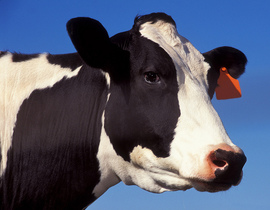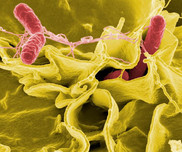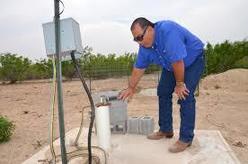|
Having trouble viewing this email? View it as a Web page.

|
|
|
Fresh from the Field is a weekly album showcasing transformative impacts made by grantees supported by the National Institute of Food and Agriculture.
NIFA
invests in and advances agricultural research, education, and extension and
seeks to make transformative discoveries that solve societal challenges.
July 27, 2017
|
|
Success Stories of the Week
 How, now, brown HIV vaccine breakthrough?
Cows are leaving the
pasture and entering the field of HIV vaccine research. Devin Sok of the Scripps
Institute and Waithaka Mwangi of Texas A&M University
discovered how to produce powerful, HIV-blocking antibodies in cows in a matter
of weeks – a process that usually takes years in humans. These unexpected
findings illuminate new pathways for HIV vaccine research.
"One approach to a
preventive HIV vaccine involves trying to elicit broadly neutralizing
antibodies in healthy people, but so far the experiments have been
unsuccessful, in both human and animal studies," said Sok, the study's
first author. "This experiment demonstrates that not only is it possible
to produce these antibodies in animals, but we can do so reliably, quickly, and
using a relatively simple immunization strategy when given in the right
setting."
The cows’ ability to
quickly produce antibodies against a complicated pathogen like HIV highlights
even broader significance, particularly for emerging pathogens.
The research was funded by
NIFA's Agriculture and Food Research Initiative.
Read about cattle antibodies and HIV research. Image provided by Peggy Greb, USDA.
|
 Stomp out salmonella
The Centers for Disease Control and Prevention (CDC) estimates
that 1 million foodborne illnesses and 380 deaths in the United States each
year can be linked to nontyphoidal salmonella. University of Georgia
food microbiologist Xiangyu Deng was awarded the 2017 Creative Research Medal
for creating a cloud-based software that quickly classifies strains of
salmonella. The SeqSero system uses whole genome sequencing to identify
particular strains of salmonella, from infected humans, animals, foods and the
environment. This system allows for quick and accurate label of any salmonella
strain and replaces a complicated, time-consuming laboratory protocol that took
place before the invention.
“This is a highly desirable bioinformatics system and allows for
push-button, fast, straightforward and accurate identification of salmonella
serotypes from raw data that comes directly off sequencers,” Deng said. “There
are more than 2,500 serotypes described for salmonella, and SeqSero focuses
primarily on more common serotypes while also being able to ID many rare
serotypes.”
The software is being used by the CDC, the U.S. Food and Drug
Administration, USDA, multiple state health departments, and more than 20
regulatory agencies in European, Asian, and North American countries.
The research was funded by NIFA’s Hatch funding.
Read more about Deng’s invention. Image provided by NIAID.
|
News Coverage
 Calories and cattle
Scientists have long been interested in
finding the genetic basis for feed efficiency, with the aim of breeding more
efficient animals. But the first step – accurately measuring how much cattle eat
across different life stages and diet types – has been a missing piece. That may be changing due to research funded by NIFA’s Agriculture and Food Research Initiative.
“Grain intake in the
feedlot is relatively easy to measure and the industry now has a substantial
number of feed intake records. But forage intake while a cow is grazing is
extremely difficult to measure. We need to get a handle on that to really
capture feed efficiency for the entire beef production system,” says Dan Shike,
associate professor of beef cattle nutrition in the Department of Animal
Sciences at the University of Illinois.
The concern is that intake
regulation varies, depending on diet type. In other words, a cow can fill up on
forages before meeting her basic nutritional requirements. The same cow being
fed grain in a controlled setting like a feedlot will likely meet those
requirements on less feed. However, feed intake evaluations are typically done
in the feedlot, potentially misrepresenting the efficiency of the animal over
her lifespan.
Read more about cattle
and diets . Image provided by University of Illinois.
|
The Library
 A lean, mean kidney bean
Kidney beans are a nutritious powerhouse. They are filled with complex
carbohydrates, protein, iron, and folate. They are also a good source of
soluble fiber, which has several health benefits such as lowering cholesterol.
Two new varieties of
kidney beans – Talon and Rosie – have been released by a team of
researchers led by Juan Osorno at North Dakota State University. Both varieties “possess improved resistance to root pathogens and bacterial
diseases,” says Osorno. “They also show higher seed yields and superior
performance compared to older varieties.”
Improved resistance to
root rot, which is caused by fungal pathogens, is especially important for
kidney beans. “Their root systems are often weaker than other beans,” says
Osorno. “They are more susceptible to root diseases. So anything we can do to
improve these root systems is very helpful for farmers.”
The research was supported
by NIFA's Multistate Research
Fund.
Read more at the American Society of Agronomy.
|
Video
 Sunshine power for farmers
Agricultural food
production accounts for a large portion of water use in the United States. The University
of Arkansas Cooperative Extension Service is helping local farmers in
Randolph County save water resources using the power of the sun. Farmers are using
solar-powered surge valves that improve irrigation, water conversation, fuel
and energy. The technology allows water to alternate flow to different segments
of the field throughout the day using a type of rudder. University of
Arkansas Cooperative Extension agent Mike Andrew notes the technique is
currently being used on a variety of crops including peanuts, soybeans and
corn. “The water will run out of the field on each row at about the same time
and we don’t have the short rows running out for 12 hours and wasting that
water,” Andrews said.
Watch the WDAM news story. Image provided by USDA.
|
Tweet of the Week
#NIFAIMPACTS

|
|

For more NIFA Impacts, visit nifa.usda.gov/impacts or the Land-Grant University Impacts website. Send us your NIFA-funded impacts at Impactstories@nifa.usda.gov or share them with USDA_NIFA on Twitter #NIFAImpacts.
NIFA invests in and advances agricultural research, education, and extension and promotes transformative discoveries that solve societal challenges.
Fresh from the Field is a weekly compendium of news and information that may be of interest to land-grant and non-land-grant universities, NIFA stakeholders, and other subscribers.
Editor: Falita Liles; Co Editor: Carlos Harris
|
|